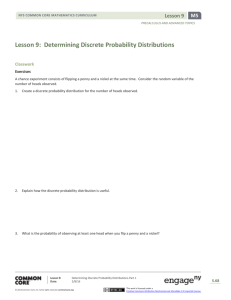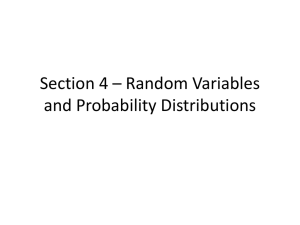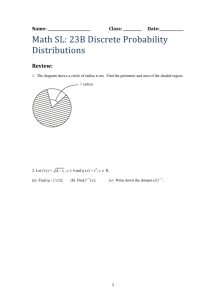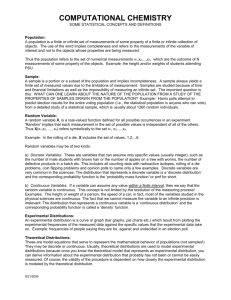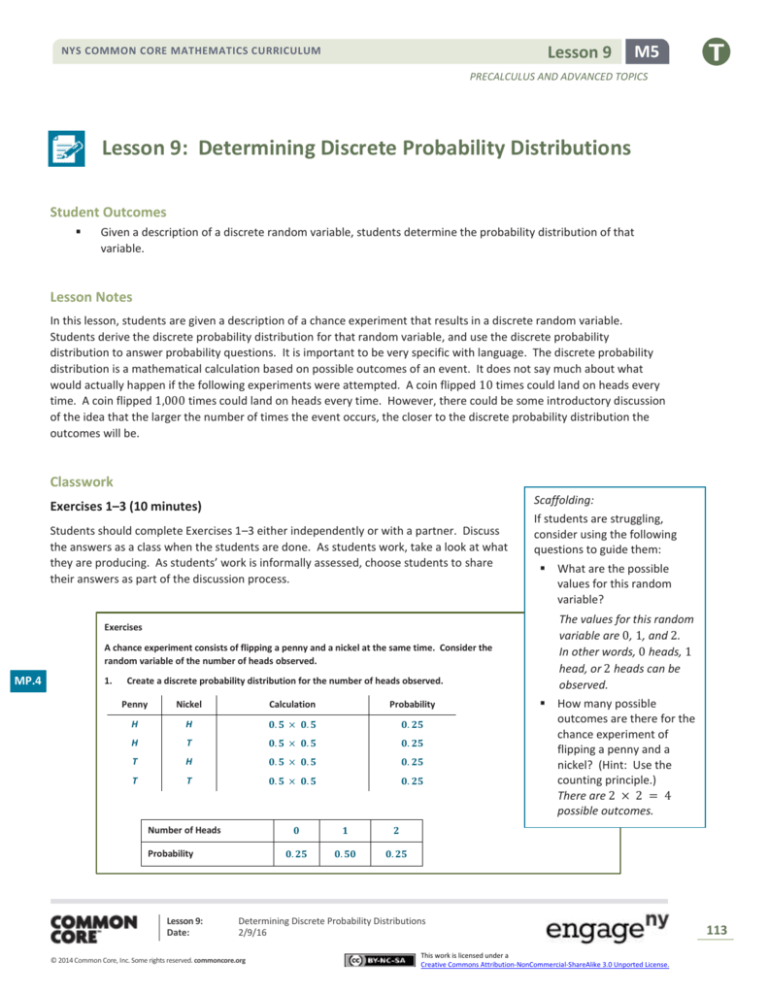
Lesson 9
NYS COMMON CORE MATHEMATICS CURRICULUM
M5
PRECALCULUS AND ADVANCED TOPICS
Lesson 9: Determining Discrete Probability Distributions
Student Outcomes
Given a description of a discrete random variable, students determine the probability distribution of that
variable.
Lesson Notes
In this lesson, students are given a description of a chance experiment that results in a discrete random variable.
Students derive the discrete probability distribution for that random variable, and use the discrete probability
distribution to answer probability questions. It is important to be very specific with language. The discrete probability
distribution is a mathematical calculation based on possible outcomes of an event. It does not say much about what
would actually happen if the following experiments were attempted. A coin flipped 10 times could land on heads every
time. A coin flipped 1,000 times could land on heads every time. However, there could be some introductory discussion
of the idea that the larger the number of times the event occurs, the closer to the discrete probability distribution the
outcomes will be.
Classwork
Scaffolding:
Exercises 1–3 (10 minutes)
Students should complete Exercises 1–3 either independently or with a partner. Discuss
the answers as a class when the students are done. As students work, take a look at what
they are producing. As students’ work is informally assessed, choose students to share
their answers as part of the discussion process.
Exercises
A chance experiment consists of flipping a penny and a nickel at the same time. Consider the
random variable of the number of heads observed.
MP.4
1.
Create a discrete probability distribution for the number of heads observed.
Penny
Nickel
Calculation
Probability
H
H
𝟎. 𝟓 × 𝟎. 𝟓
𝟎. 𝟐𝟓
H
T
𝟎. 𝟓 × 𝟎. 𝟓
𝟎. 𝟐𝟓
T
H
𝟎. 𝟓 × 𝟎. 𝟓
𝟎. 𝟐𝟓
T
T
𝟎. 𝟓 × 𝟎. 𝟓
𝟎. 𝟐𝟓
Number of Heads
Probability
Lesson 9:
Date:
𝟎
𝟏
𝟐
𝟎. 𝟐𝟓
𝟎. 𝟓𝟎
𝟎. 𝟐𝟓
If students are struggling,
consider using the following
questions to guide them:
What are the possible
values for this random
variable?
The values for this random
variable are 0, 1, and 2.
In other words, 0 heads, 1
head, or 2 heads can be
observed.
How many possible
outcomes are there for the
chance experiment of
flipping a penny and a
nickel? (Hint: Use the
counting principle.)
There are 2 × 2 = 4
possible outcomes.
Determining Discrete Probability Distributions
2/9/16
© 2014 Common Core, Inc. Some rights reserved. commoncore.org
This work is licensed under a
Creative Commons Attribution-NonCommercial-ShareAlike 3.0 Unported License.
113
Lesson 9
NYS COMMON CORE MATHEMATICS CURRICULUM
M5
PRECALCULUS AND ADVANCED TOPICS
2.
Explain how the discrete probability distribution is useful.
It can be used to help make predictions. For example, if the scenario presents a game where I could win a prize for
guessing the correct number of heads, I would choose 𝟏 head since the probability of only one head appearing is
𝟎. 𝟓.
3.
Scaffolding:
What is the probability of observing at least one head when you flip a penny and a nickel?
Consider having students
above-grade level attempt the
following extension to the
lesson:
The probability of tossing at least one head is as follows
𝑷(𝟏 𝐡𝐞𝐚𝐝) + 𝑷(𝟐 𝐡𝐞𝐚𝐝𝐬) = 𝟎. 𝟓𝟎 + 𝟎. 𝟐𝟓 = 𝟎. 𝟕𝟓
Exercises 4–6 (12 minutes)
Students can work independently or with a partner to complete Exercises 4–6. Be sure
that students complete the tables correctly. Discuss the answers when students are done.
As students progress from Exercises 1–3 to Exercises 4–6, they should notice that, if
outcomes are composed of 𝑗 events, then there are 2𝑗 possible outcomes. (This may be a
good introductory question.) Also, they should understand that probabilities asking for at
least or at most are calculated by addition. Since these outcomes are discrete,
multiplication does not make sense. (It is not possible for two coins to come up both
heads and both tails.)
Suppose that on a particular island, 𝟔𝟎% of the eggs of a certain type of bird are female. You
spot a nest of this bird and find three eggs. You are interested in the number of male eggs.
Assume the gender of each egg is independent of the other eggs in the nest.
MP.4
4.
Create a discrete probability distribution for the number of male eggs in the nest.
Egg 1
Egg 2
Egg 3
Calculation
Probability
F
F
F
𝟎. 𝟔 × 𝟎. 𝟔 × 𝟎. 𝟔
𝟎. 𝟐𝟏𝟔
F
F
M
𝟎. 𝟔 × 𝟎. 𝟔 × 𝟎. 𝟒
𝟎. 𝟏𝟒𝟒
F
M
F
𝟎. 𝟔 × 𝟎. 𝟒 × 𝟎. 𝟔
𝟎. 𝟏𝟒𝟒
F
M
M
𝟎. 𝟔 × 𝟎. 𝟒 × 𝟎. 𝟒
𝟎. 𝟎𝟗𝟔
M
F
F
𝟎. 𝟒 × 𝟎. 𝟔 × 𝟎. 𝟔
𝟎. 𝟏𝟒𝟒
M
F
M
𝟎. 𝟒 × 𝟎. 𝟔 × 𝟎. 𝟒
𝟎. 𝟎𝟗𝟔
M
M
F
𝟎. 𝟒 × 𝟎. 𝟒 × 𝟎. 𝟔
𝟎. 𝟎𝟗𝟔
M
M
M
𝟎. 𝟒 × 𝟎. 𝟒 × 𝟎. 𝟒
𝟎. 𝟎𝟔𝟒
Number of Male Eggs
Probability
5.
𝟎
𝟏
𝟐
𝟑
𝟎. 𝟐𝟏𝟔
𝟎. 𝟒𝟑𝟐
𝟎. 𝟐𝟖𝟖
𝟎. 𝟎𝟔𝟒
Invent a scenario that
requires the calculation of
a probability distribution.
(Perhaps provide a broad
topic, such as food or
shoes to help focus their
brainstorming.)
Their scenarios and
probabilities do not
necessarily need to be
research-based (they
could be fictional), but
their probability
distributions should be
accurate for their
scenarios.
What is the probability that no more than two eggs are male?
The probability that no more than two eggs are male is as follows
𝟎. 𝟐𝟏𝟔 + 𝟎. 𝟒𝟑𝟐 + 𝟎. 𝟐𝟖𝟖 = 𝟎. 𝟗𝟑𝟔
Lesson 9:
Date:
Determining Discrete Probability Distributions
2/9/16
© 2014 Common Core, Inc. Some rights reserved. commoncore.org
This work is licensed under a
Creative Commons Attribution-NonCommercial-ShareAlike 3.0 Unported License.
114
Lesson 9
NYS COMMON CORE MATHEMATICS CURRICULUM
M5
PRECALCULUS AND ADVANCED TOPICS
6.
Explain the similarities and differences between this probability distribution and the one in the first part of the
lesson.
The distributions are similar because the events are independent in both cases, so the probability of each outcome
can be determined by multiplying the probabilities of the events. The distributions are different because the number
of values for each of the random variables is different.
Exercise 7 (15 minutes)
Begin work on this exercise as a whole class. Assign various students to perform the individual probability calculations.
Then, combine class results and have students complete the remainder of the exercise independently. Consider asking
students what they think it means to be a satisfied customer.
7.
The manufacturer of a certain type of tire claims that only 𝟓% of the tires are defective. All four of your tires need
to be replaced. What is the probability you would be a satisfied customer if you purchased all four tires from this
manufacturer? Would you purchase from this manufacturer? Explain your answer using a probability distribution.
Tire 1
Tire 2
Tire 3
Tire 4
Calculation
Probability
D
D
D
D
𝟎. 𝟎𝟓 × 𝟎. 𝟎𝟓 × 𝟎. 𝟎𝟓 × 𝟎. 𝟎𝟓
𝟎. 𝟎𝟎𝟎𝟎𝟎𝟔𝟐𝟓
D
D
D
ND
𝟎. 𝟎𝟓 × 𝟎. 𝟎𝟓 × 𝟎. 𝟎𝟓 × 𝟎. 𝟗𝟓
𝟎. 𝟎𝟎𝟎𝟏𝟏𝟖𝟕𝟓
D
D
ND
D
𝟎. 𝟎𝟓 × 𝟎. 𝟎𝟓 × 𝟎. 𝟗𝟓 × 𝟎. 𝟎𝟓
𝟎. 𝟎𝟎𝟎𝟏𝟏𝟖𝟕𝟓
D
ND
D
D
𝟎. 𝟎𝟓 × 𝟎. 𝟗𝟓 × 𝟎. 𝟎𝟓 × 𝟎. 𝟎𝟓
𝟎. 𝟎𝟎𝟎𝟏𝟏𝟖𝟕𝟓
D
D
ND
ND
𝟎. 𝟎𝟓 × 𝟎. 𝟎𝟓 × 𝟎. 𝟗𝟓 × 𝟎. 𝟗𝟓
𝟎. 𝟎𝟎𝟐𝟐𝟓𝟔𝟐𝟓
D
ND
D
ND
𝟎. 𝟎𝟓 × 𝟎. 𝟗𝟓 × 𝟎. 𝟎𝟓 × 𝟎. 𝟗𝟓
𝟎. 𝟎𝟎𝟐𝟐𝟓𝟔𝟐𝟓
D
ND
ND
D
𝟎. 𝟎𝟓 × 𝟎. 𝟗𝟓 × 𝟎. 𝟗𝟓 × 𝟎. 𝟎𝟓
𝟎. 𝟎𝟎𝟐𝟐𝟓𝟔𝟐𝟓
D
ND
ND
ND
𝟎. 𝟎𝟓 × 𝟎. 𝟗𝟓 × 𝟎. 𝟗𝟓 × 𝟎. 𝟗𝟓
𝟎. 𝟎𝟒𝟐𝟖𝟔𝟖𝟕𝟓
ND
D
D
D
𝟎. 𝟗𝟓 × 𝟎. 𝟎𝟓 × 𝟎. 𝟎𝟓 × 𝟎. 𝟎𝟓
𝟎. 𝟎𝟎𝟎𝟏𝟏𝟖𝟕𝟓
ND
D
D
ND
𝟎. 𝟗𝟓 × 𝟎. 𝟎𝟓 × 𝟎. 𝟎𝟓 × 𝟎. 𝟗𝟓
𝟎. 𝟎𝟎𝟐𝟐𝟓𝟔𝟐𝟓
ND
D
ND
D
𝟎. 𝟗𝟓 × 𝟎. 𝟎𝟓 × 𝟎. 𝟗𝟓 × 𝟎. 𝟎𝟓
𝟎. 𝟎𝟎𝟐𝟐𝟓𝟔𝟐𝟓
ND
ND
D
D
𝟎. 𝟗𝟓 × 𝟎. 𝟗𝟓 × 𝟎. 𝟎𝟓 × 𝟎. 𝟎𝟓
𝟎. 𝟎𝟎𝟐𝟐𝟓𝟔𝟐𝟓
ND
D
ND
ND
𝟎. 𝟗𝟓 × 𝟎. 𝟎𝟓 × 𝟎. 𝟗𝟓 × 𝟎. 𝟗𝟓
𝟎. 𝟎𝟒𝟐𝟖𝟔𝟖𝟕𝟓
ND
ND
D
ND
𝟎. 𝟗𝟓 × 𝟎. 𝟗𝟓 × 𝟎. 𝟎𝟓 × 𝟎. 𝟗𝟓
𝟎. 𝟎𝟒𝟐𝟖𝟔𝟖𝟕𝟓
ND
ND
ND
D
𝟎. 𝟗𝟓 × 𝟎. 𝟗𝟓 × 𝟎. 𝟗𝟓 × 𝟎. 𝟎𝟓
𝟎. 𝟎𝟒𝟐𝟖𝟔𝟖𝟕𝟓
ND
ND
ND
ND
𝟎. 𝟗𝟓 × 𝟎. 𝟗𝟓 × 𝟎. 𝟗𝟓 × 𝟎. 𝟗𝟓
𝟎. 𝟖𝟏𝟒𝟓𝟎𝟔𝟐𝟓
Note: D stands for “defective,” and ND stands for “not defective.”
Number of Defective Tires
Probability
𝟎
𝟏
𝟐
𝟑
𝟒
𝟎. 𝟖𝟏𝟒𝟓𝟎𝟔𝟐𝟓
𝟎. 𝟏𝟕𝟏𝟒𝟕𝟓
𝟎. 𝟎𝟏𝟑𝟓𝟑𝟕𝟓
𝟎. 𝟎𝟎𝟎𝟒𝟕𝟓
𝟎. 𝟎𝟎𝟎𝟎𝟎𝟔𝟐𝟓
To be a satisfied customer, 𝟎 tires would be defective. The probability of this happening is 𝟎. 𝟖𝟏𝟒𝟓𝟎𝟔𝟐𝟓.
Answers will vary about whether students would purchase tires from this manufacturer, but this could lead to a
discussion about whether this probability is “good enough.”
Lesson 9:
Date:
Determining Discrete Probability Distributions
2/9/16
© 2014 Common Core, Inc. Some rights reserved. commoncore.org
This work is licensed under a
Creative Commons Attribution-NonCommercial-ShareAlike 3.0 Unported License.
115
Lesson 9
NYS COMMON CORE MATHEMATICS CURRICULUM
M5
PRECALCULUS AND ADVANCED TOPICS
Some sample discussion points:
𝟖𝟏% is fairly high, but that means that there is a 𝟏𝟗% chance that at least one tire is defective.
According to this model, about 𝟏 in 𝟓 cars is expected to have at least one defective tire.
Going further: Why is the probability for a vehicle to have at least one defective tire so much higher
than the 𝟓% defect rate? Is the advertised defect rate of 𝟓% misleading?
Closing (3 minutes)
Ask students to explain the concept in writing and share their answer with a neighbor: Explain what a discrete
probability distribution is and how is it useful.
Sample response: A discrete probability distribution is the set of calculated probabilities of every
possible outcome of a series of events. It is useful because it allows us to make predictions about what
might happen if we attempted to actually test these events. It is also useful when determining the best
course of action to take, as in a game, for instance.
To calculate the corresponding probabilities for the values of a random variable, add the individual
probabilities for all outcomes that correspond to the value.
Ask students to summarize the main ideas of the lesson in writing or with a neighbor. Use this as an
opportunity to informally assess comprehension of the lesson. The Lesson Summary below offers some
important ideas that should be included.
Lesson Summary
To derive a probability distribution for a discrete random variable, you must consider all possible
outcomes of the chance experiment.
A discrete probability distribution displays all possible values of a random variable and the
corresponding probabilities.
Exit Ticket (5 minutes)
Lesson 9:
Date:
Determining Discrete Probability Distributions
2/9/16
© 2014 Common Core, Inc. Some rights reserved. commoncore.org
This work is licensed under a
Creative Commons Attribution-NonCommercial-ShareAlike 3.0 Unported License.
116
Lesson 9
NYS COMMON CORE MATHEMATICS CURRICULUM
M5
PRECALCULUS AND ADVANCED TOPICS
Name
Date
Lesson 9: Determining Discrete Probability Distributions
Exit Ticket
Suppose that an estimated 10% of the inhabitants of a large island have a certain gene. If pairs of islanders are selected
at random and tested for the gene, what is the probability that one or both islanders are carriers? Explain your answer
using a probability distribution.
Lesson 9:
Date:
Determining Discrete Probability Distributions
2/9/16
© 2014 Common Core, Inc. Some rights reserved. commoncore.org
This work is licensed under a
Creative Commons Attribution-NonCommercial-ShareAlike 3.0 Unported License.
117
Lesson 9
NYS COMMON CORE MATHEMATICS CURRICULUM
M5
PRECALCULUS AND ADVANCED TOPICS
Exit Ticket Sample Solutions
Suppose that an estimated 𝟏𝟎% of the inhabitants of a large island have a certain gene. If pairs of islanders are selected
at random and tested for the gene, what is the probability that one or both islanders are carriers? Explain your answer
using a probability distribution.
Person 1
Person 2
Calculation
Probability
Y
Y
𝟎. 𝟏𝟎 × 𝟎. 𝟏𝟎
𝟎. 𝟎𝟏
Y
N
𝟎. 𝟏𝟎 × 𝟎. 𝟗𝟎
𝟎. 𝟎𝟗
N
Y
𝟎. 𝟗𝟎 × 𝟎. 𝟏𝟎
𝟎. 𝟎𝟗
N
N
𝟎. 𝟗𝟎 × 𝟎. 𝟗𝟎
𝟎. 𝟖𝟏
Number of Islanders with the Gene
Probability
𝟎
𝟏
𝟐
𝟎. 𝟖𝟏
𝟎. 𝟏𝟖
𝟎. 𝟎𝟏
The probability that one or both islanders are carriers is as follows
𝟎. 𝟏𝟖 + 𝟎. 𝟎𝟏 = 𝟎. 𝟏𝟗
Problem Set Sample Solutions
1.
About 𝟏𝟏% of adult Americans are left-handed. Suppose that two people are randomly selected from this
population.
a.
Create a discrete probability distribution for the number of left-handed people in a sample of two randomly
selected adult Americans.
Person 1
Person 2
Calculation
Probability
L
L
𝟎. 𝟏𝟏 × 𝟎. 𝟏𝟏
𝟎. 𝟎𝟏𝟐𝟏
L
R
𝟎. 𝟏𝟏 × 𝟎. 𝟖𝟗
𝟎. 𝟎𝟗𝟕𝟗
R
L
𝟎. 𝟖𝟗 × 𝟎. 𝟏𝟏
𝟎. 𝟎𝟗𝟕𝟗
R
R
𝟎. 𝟖𝟗 × 𝟎. 𝟖𝟗
𝟎. 𝟕𝟗𝟐𝟏
Note: L stands for “left-handed,” and R stands for “right-handed”
Number of Left-handers
Probability
b.
𝟎
𝟏
𝟐
𝟎. 𝟕𝟗𝟐𝟏
𝟎. 𝟏𝟗𝟓𝟖
𝟎. 𝟎𝟏𝟐𝟏
What is the probability that at least one person in the sample is left-handed?
The probability that at least one person is left-handed is as follows
𝟎. 𝟏𝟗𝟓𝟖 + 𝟎. 𝟎𝟏𝟐𝟏 = 𝟎. 𝟐𝟎𝟕𝟗
Lesson 9:
Date:
Determining Discrete Probability Distributions
2/9/16
© 2014 Common Core, Inc. Some rights reserved. commoncore.org
This work is licensed under a
Creative Commons Attribution-NonCommercial-ShareAlike 3.0 Unported License.
118
Lesson 9
NYS COMMON CORE MATHEMATICS CURRICULUM
M5
PRECALCULUS AND ADVANCED TOPICS
2.
In a large batch of M&M candies, about 𝟐𝟒% of the candies are blue. Suppose that three candies are randomly
selected from the large batch.
a.
Create a discrete probability distribution for the number of blue candies out of the three randomly selected
candies.
Candy 1
Candy 2
Candy 3
Calculation
Probability
B
B
B
𝟎. 𝟐𝟒 × 𝟎. 𝟐𝟒 × 𝟎. 𝟐𝟒
𝟎. 𝟎𝟏𝟑𝟖𝟐𝟒
B
B
NB
𝟎. 𝟐𝟒 × 𝟎. 𝟐𝟒 × 𝟎. 𝟕𝟔
𝟎. 𝟎𝟒𝟑𝟕𝟕𝟔
B
NB
B
𝟎. 𝟐𝟒 × 𝟎. 𝟕𝟔 × 𝟎. 𝟐𝟒
𝟎. 𝟎𝟒𝟑𝟕𝟕𝟔
B
NB
NB
𝟎. 𝟐𝟒 × 𝟎. 𝟕𝟔 × 𝟎. 𝟕𝟔
𝟎. 𝟏𝟑𝟖𝟔𝟐𝟒
NB
B
B
𝟎. 𝟕𝟔 × 𝟎. 𝟐𝟒 × 𝟎. 𝟐𝟒
𝟎. 𝟎𝟒𝟑𝟕𝟕𝟔
NB
B
NB
𝟎. 𝟕𝟔 × 𝟎. 𝟐𝟒 × 𝟎. 𝟕𝟔
𝟎. 𝟏𝟑𝟖𝟔𝟐𝟒
NB
NB
B
𝟎. 𝟕𝟔 × 𝟎. 𝟕𝟔 × 𝟎. 𝟐𝟒
𝟎. 𝟏𝟑𝟖𝟔𝟐𝟒
NB
NB
NB
𝟎. 𝟕𝟔 × 𝟎. 𝟕𝟔 × 𝟎. 𝟕𝟔
𝟎. 𝟒𝟑𝟖𝟗𝟕𝟔
Note: B stands for “blue candy,” and NB stands for “not blue candy.”
Number of Blue Candies
Probability
b.
𝟎
𝟏
𝟐
𝟑
𝟎. 𝟒𝟑𝟖𝟗𝟕𝟔
𝟎. 𝟒𝟏𝟓𝟖𝟕𝟐
𝟎. 𝟏𝟑𝟏𝟑𝟐𝟖
𝟎. 𝟎𝟏𝟑𝟖𝟐𝟒
What is probability that at most two candies are blue? Explain how you know.
The probability that at most two candies are blue is as follows:
𝟎. 𝟒𝟑𝟖𝟗𝟕𝟔 + 𝟎. 𝟒𝟏𝟓𝟖𝟕𝟐 + 𝟎. 𝟏𝟑𝟏𝟑𝟐𝟖 = 𝟎. 𝟗𝟖𝟔𝟏𝟕𝟔
3.
In the 21st century, about 𝟑% of mothers give birth to twins. Suppose three mothers-to-be are chosen at random.
a.
Create a discrete probability distribution for the number of sets of twins born from the sample.
Mother 1
Mother 2
Mother 3
Calculation
Probability
T
T
T
𝟎. 𝟎𝟑 × 𝟎. 𝟎𝟑 × 𝟎. 𝟎𝟑
𝟎. 𝟎𝟎𝟎𝟎𝟐𝟕
T
T
NT
𝟎. 𝟎𝟑 × 𝟎. 𝟎𝟑 × 𝟎. 𝟗𝟕
𝟎. 𝟎𝟎𝟎𝟖𝟕𝟑
T
NT
T
𝟎. 𝟎𝟑 × 𝟎. 𝟗𝟕 × 𝟎. 𝟎𝟑
𝟎. 𝟎𝟎𝟎𝟖𝟕𝟑
T
NT
NT
𝟎. 𝟎𝟑 × 𝟎. 𝟗𝟕 × 𝟎. 𝟗𝟕
𝟎. 𝟎𝟐𝟖𝟐𝟐𝟕
NT
T
T
𝟎. 𝟗𝟕 × 𝟎. 𝟎𝟑 × 𝟎. 𝟎𝟑
𝟎. 𝟎𝟎𝟎𝟖𝟕𝟑
NT
T
NT
𝟎. 𝟗𝟕 × 𝟎. 𝟎𝟑 × 𝟎. 𝟗𝟕
𝟎. 𝟎𝟐𝟖𝟐𝟐𝟕
NT
NT
T
𝟎. 𝟗𝟕 × 𝟎. 𝟗𝟕 × 𝟎. 𝟎𝟑
𝟎. 𝟎𝟐𝟖𝟐𝟐𝟕
NT
NT
NT
𝟎. 𝟗𝟕 × 𝟎. 𝟗𝟕 × 𝟎. 𝟗𝟕
𝟎. 𝟗𝟏𝟐𝟔𝟕𝟑
Note: T stands for “twins,” and NT stands for “not twins.”
Number of Mothers who Have Twins
Probability
b.
𝟎
𝟏
𝟐
𝟑
𝟎. 𝟗𝟏𝟐𝟔𝟕𝟑
𝟎. 𝟎𝟖𝟒𝟔𝟖𝟏
𝟎. 𝟎𝟎𝟐𝟔𝟏𝟗
𝟎. 𝟎𝟎𝟎𝟎𝟐𝟕
What is the probability that at least one of the three mothers did not give birth to twins?
𝟎. 𝟗𝟏𝟐𝟔𝟕𝟑 + 𝟎. 𝟎𝟖𝟒𝟔𝟖𝟏 + 𝟎. 𝟎𝟎𝟐𝟔𝟏𝟗 = 𝟎. 𝟗𝟗𝟗𝟗𝟕𝟑
Lesson 9:
Date:
Determining Discrete Probability Distributions
2/9/16
© 2014 Common Core, Inc. Some rights reserved. commoncore.org
This work is licensed under a
Creative Commons Attribution-NonCommercial-ShareAlike 3.0 Unported License.
119
Lesson 9
NYS COMMON CORE MATHEMATICS CURRICULUM
M5
PRECALCULUS AND ADVANCED TOPICS
4.
About three in 𝟓𝟎𝟎 people have type O-negative blood. Though it is one of the least frequently-occurring blood
types, it is one of the most sought after because it can be donated to people who have any blood type.
a.
Create a discrete probability distribution for the number of people who have type O-negative blood in a
sample of two randomly selected adult Americans.
Person 1
Person 2
Calculation
Probability
O
O
𝟎. 𝟎𝟎𝟔 × 𝟎. 𝟎𝟎𝟔
𝟎. 𝟎𝟎𝟎𝟎𝟑𝟔
O
NO
𝟎. 𝟎𝟎𝟔 × 𝟎. 𝟗𝟗𝟒
𝟎. 𝟎𝟎𝟓𝟗𝟔𝟒
NO
O
𝟎. 𝟗𝟗𝟒 × 𝟎. 𝟎𝟎𝟔
𝟎. 𝟎𝟎𝟓𝟗𝟔𝟒
NO
NO
𝟎. 𝟗𝟗𝟒 × 𝟎. 𝟗𝟗𝟒
𝟎. 𝟗𝟖𝟖𝟎𝟑𝟔
Note: O stands for “O-negative,” and NO stands for “not O-negative.”
𝟎
𝟏
𝟐
𝟎. 𝟗𝟖𝟖𝟎𝟑𝟔
𝟎. 𝟎𝟏𝟏𝟗𝟐𝟖
𝟎. 𝟎𝟎𝟎𝟎𝟑𝟔
Number of People with Type O-Negative Blood
Probability
b.
Suppose two samples of two people are taken. What is the probability that at least one person in each
sample has type O-negative blood?
(𝟎. 𝟎𝟏𝟏𝟗𝟐𝟖 + 𝟎. 𝟎𝟎𝟎𝟎𝟑𝟔)𝟐 = 𝟎. 𝟎𝟎𝟎𝟏𝟒𝟑
5.
The probability of being struck by lightning in one’s lifetime is approximately 𝟏 in 𝟑, 𝟎𝟎𝟎.
a.
What is the probability of being struck by lightning twice in one’s lifetime?
(𝟎. 𝟎𝟎𝟎𝟑𝟑𝟑)𝟐 = 𝟎. 𝟎𝟎𝟎𝟎𝟎𝟎𝟏𝟏𝟏
b.
In a random sample of three adult Americans, how likely is it that at least one has been struck by lightning
exactly twice?
Person 1
Person 2
Person 3
Calculation
Probability
T
T
T
𝟎. 𝟎𝟎𝟎𝟎𝟎𝟎𝟏𝟏𝟏 × 𝟎. 𝟎𝟎𝟎𝟎𝟎𝟎𝟏𝟏𝟏 × 𝟎. 𝟎𝟎𝟎𝟎𝟎𝟎𝟏𝟏𝟏
𝟏. 𝟑𝟔𝟕𝟔 × 𝟏𝟎−𝟐𝟏
T
T
NT
𝟎. 𝟎𝟎𝟎𝟎𝟎𝟎𝟏𝟏𝟏 × 𝟎. 𝟎𝟎𝟎𝟎𝟎𝟎𝟏𝟏𝟏 × 𝟎. 𝟗𝟗𝟗𝟗𝟗𝟗𝟖𝟖𝟗
𝟏. 𝟐𝟑𝟐𝟏 × 𝟏𝟎−𝟏𝟒
T
NT
T
𝟎. 𝟎𝟎𝟎𝟎𝟎𝟎𝟏𝟏𝟏 × 𝟎. 𝟗𝟗𝟗𝟗𝟗𝟗𝟖𝟖𝟗 × 𝟎. 𝟎𝟎𝟎𝟎𝟎𝟎𝟏𝟏𝟏
𝟏. 𝟐𝟑𝟐𝟏 × 𝟏𝟎−𝟏𝟒
T
NT
NT
𝟎. 𝟎𝟎𝟎𝟎𝟎𝟎𝟏𝟏𝟏 × 𝟎. 𝟗𝟗𝟗𝟗𝟗𝟗𝟖𝟖𝟗 × 𝟎. 𝟗𝟗𝟗𝟗𝟗𝟗𝟖𝟖𝟗
𝟏. 𝟏𝟎𝟗𝟗 × 𝟏𝟎−𝟕
NT
T
T
𝟎. 𝟗𝟗𝟗𝟗𝟗𝟗𝟖𝟖𝟗 × 𝟎. 𝟎𝟎𝟎𝟎𝟎𝟎𝟏𝟏𝟏 × 𝟎. 𝟎𝟎𝟎𝟎𝟎𝟎𝟏𝟏𝟏
𝟏. 𝟐𝟑𝟐𝟏 × 𝟏𝟎−𝟏𝟒
NT
T
NT
𝟎. 𝟗𝟗𝟗𝟗𝟗𝟗𝟖𝟖𝟗 × 𝟎. 𝟎𝟎𝟎𝟎𝟎𝟎𝟏𝟏𝟏 × 𝟎. 𝟗𝟗𝟗𝟗𝟗𝟗𝟖𝟖𝟗
𝟏. 𝟏𝟎𝟗𝟗 × 𝟏𝟎−𝟕
NT
NT
T
𝟎. 𝟗𝟗𝟗𝟗𝟗𝟗𝟖𝟖𝟗 × 𝟎. 𝟗𝟗𝟗𝟗𝟗𝟗𝟖𝟖𝟗 × 𝟎. 𝟎𝟎𝟎𝟎𝟎𝟎𝟏𝟏𝟏
𝟏. 𝟏𝟎𝟗𝟗 × 𝟏𝟎−𝟕
NT
NT
NT
𝟎. 𝟗𝟗𝟗𝟗𝟗𝟗𝟖𝟖𝟗 × 𝟎. 𝟗𝟗𝟗𝟗𝟗𝟗𝟖𝟖𝟗 × 𝟎. 𝟗𝟗𝟗𝟗𝟗𝟗𝟖𝟖𝟗
𝟎. 𝟗𝟗𝟗𝟗𝟗𝟗𝟔𝟔𝟕
Note: T stands for “twice,” and NT stands for “not twice.”
Number of People Struck Twice by
Lightning
Probability
𝟎
𝟏
𝟐
𝟑
𝟎. 𝟗𝟗𝟗𝟗𝟗𝟗𝟔𝟔𝟕
𝟑. 𝟑𝟐𝟗𝟕 × 𝟏𝟎−𝟕
𝟑. 𝟔𝟗𝟔𝟑 × 𝟏𝟎−𝟏𝟒
𝟏. 𝟑𝟔𝟕𝟔 × 𝟏𝟎−𝟐𝟏
The probability that at least one person has been struck exactly twice by lightning is as follows:
𝟑. 𝟑𝟐𝟗𝟕 × 𝟏𝟎−𝟕 + 𝟑. 𝟔𝟗𝟔𝟑 × 𝟏𝟎−𝟏𝟒 + 𝟏. 𝟑𝟔𝟕𝟔 × 𝟏𝟎−𝟐𝟏 = 𝟑. 𝟑𝟐𝟗𝟕𝟎𝟎𝟑𝟕 × 𝟏𝟎−𝟕
Lesson 9:
Date:
Determining Discrete Probability Distributions
2/9/16
© 2014 Common Core, Inc. Some rights reserved. commoncore.org
This work is licensed under a
Creative Commons Attribution-NonCommercial-ShareAlike 3.0 Unported License.
120

